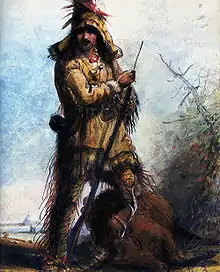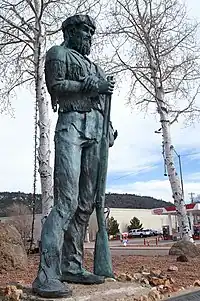"Old Bill" Williams | |
|---|---|
 Old Bill Williams by Alfred Jacob Miller | |
| Born | January 3, 1787 |
| Died | March 14, 1849 (aged 62) Southern Colorado along the Rio Grande |
| Cause of death | Killed by Ute warriors |
| Burial place | Williams, Coconino County, Arizona |
| Nationality | American |
| Occupation(s) | Mountain man, trapper, guide, interpreter |
| Spouse |
A-Ci'n-Ga
(m. 1813; died 1825) |
| Children | 2 |
| Parents |
|
| Relatives | John Allen Mathews (son-in-law)[lower-alpha 1] |
| Allegiance | |
|---|---|
| Service/ | United States Rangers |
| Rank | Sergeant and Scout |
| Battles/wars | War of 1812 |
William Sherley "Old Bill" Williams (January 3, 1787 – March 14, 1849) was a noted mountain man and frontiersman, known as Lone Elk to the Native Americans. Fluent in several languages, Williams served as an interpreter for the government and led several expeditions to the West. He assimilated into the Osage Nation where he married an Osage woman, and never returned to European-American life.
Early life and education

Williams was born on January 3, 1787, on Horse Creek, a branch of the Pacolet River, under Skyuka Mountain in Polk County, North Carolina.,[1] the fourth son and the fourth child of nine born to Joseph and Sarah (Musick) Williams.[2] He liked to explore and learned to trap animals for their furs, and found he had a gift for languages. In 1795, the family moved to settle near St. Louis, Missouri.[3]
Career
Williams was a master fur trapper and trail guide, becoming fluent in several Native American languages among the tribes he knew the best. He served as a sergeant and scout with the United States Rangers during the War of 1812. As he encountered local tribes, Williams would learn their languages and customs.[4] His ability to communicate in the different languages made him valuable to the government and the military for tribal negotiations.[5]
Life among the Osage
After military service, Williams became a Protestant preacher, and worked with some of the Native American tribes, moving west from Missouri to frontier areas.[5] During his early years, he lived with the Osage Indians in Missouri, and later with the Ute Indians.[1][6] While residing with the Osage people he became fluent in their language, created an Osage language dictionary, and helped translate the Bible into Osage. He was called "Red-Headed Shooter" by the Osage and left after the death of his wife in 1825.[7]
Marriage and children
Williams married A-Ci'n-Ga, a full-blood Osage woman whose name translates to "Wind Blossom",[lower-alpha 2] circa 1813. A-Ci'n-Ga was a member of the Big Hill band and the Buffalo clan. He courted her in the traditional Osage fashion, gifting her parents horses and asking their consent for the marriage. They had two children: Mary Ann Williams, born in 1814; and Sarah Williams, born in 1816. After A-Ci'n-Ga's death between 1819 and 1825, he sent his two daughters to boarding school in Kentucky where they met John Allen Mathews.[7] Mary Ann married Mathews in the mid-1830s and after her death in 1843, Mathews married her sister Sara.[8] Williams great-grandson thru Sara is John Joseph Mathews.[7]
Travels West
By 1822 he was working as an independent trapper,[6] and also guided travelers through the far western frontier of the time. He was a respected figure among the mountain men and worked with many, including Uncle Dick Wooton,[9] Joe Walker, Alexis Godey, George Nidever, Zenas Leonard, Antoine Leroux,[1] Lucien Maxwell,[9] William Thomas Hamilton,[10] Dick Owens,[9] Kit Carson,[9] and, infamously, with John C. Frémont[1][11] on his fourth expedition.[2] As an Indian fighter, he had noted encounters with Blackfeet, Apache, Comanche, and Modoc Indians.[2][4][5]
Williams traveled through a wide territory, including Texas, California, the Rocky Mountains, Yellowstone, the Santa Fe Trail, Arizona, and the Colorado and Little Colorado River regions.[1][4][12][9][11] Williams was with Joseph Walker's historic expedition which found, but did not enter, the Yosemite Valley.[2][6][13]
Williams reputation declined toward the end of his life. Historian Michael Snyder, a Oklahoma State University professor and Osage Nation citizen, wrote "Old Bill degenerated as he aged, becoming increasingly dirty, drunk, and dishonorable."[14] During an expedition in 1833, he was noted for showing "utter disregard" for the lives of Indians and in another instance he's claimed to have killed 25 innocent Indians. He also frequently stole horses from Spanish missions during his expeditions.[15]
Frémont's Fourth Expedition controversy
In November 1848 Frémont sought Williams to lead a transcontinental railroad survey into Sangre de Cristo range after other mountain men had rejected Frémont's proposition. Once the team entered the mountains, Williams changed his mind due to the heavy early snowfall. He warned the party against continuing and insisted on a southern route. Frémont continued, and the expedition was defeated within the San Juan Mountains, where 10 expedition members died of starvation and exposure.[2][1][6][9][11]
Death
Williams died in March 1849, at age 62 when he was mistakenly ambushed and killed by Ute warriors. He had been returning to Taos, New Mexico after retracing the trail of an expedition in order to help find survivors.[2][16][6]
Legacy and honors
"Old Bill" is portrayed in an 8-foot-tall bronze sculpture by B. R. Pettit, erected in 1980 in Bill Williams Monument Park in Williams, Arizona.[9] In addition to the park and town, several places and organizations in Arizona were named after him: Bill Williams River and Bill Williams Mountain,[17] the Bill Williams Mountain Men of Williams, Arizona chapter of the Pioneer Club, and the Chautauqua Program: "Rendezvous With Old Bill Williams".[18] He was portrayed by Slim Pickens in a Disney series entitled The Saga of Andy Burnett.
Notes
References
- 1 2 3 4 5 6 "Bill Williams". Retrieved 27 October 2016.
- 1 2 3 4 5 6 Favour 1962.
- ↑ Mathews 1961, p. vii.
- 1 2 3 "William Sherley 'Old Bill' Williams", Legends of America; Explorers, Trappers, Traders & Mountain Men,
- 1 2 3 All Things William, William Sherle Williams
- 1 2 3 4 5 "William Sherley Williams", The Columbia Encyclopedia
- 1 2 3 4 Snyder 2017, p. 8.
- ↑ Snyder 2017, p. 9-10.
- 1 2 3 4 5 6 7 "Old Santa Fe Trail: The Story of a Great Highway, Bill Williams, Mountain Man" Archived 2012-03-07 at the Wayback Machine, Mountain Man Bronzes
- ↑ Joseph Norman Heard (1987). Handbook of the American Frontier: The far west. Scarecrow Press. pp. 128–129. ISBN 978-0-8108-3283-1.
- 1 2 3 "Old Bill lives on – Bill Williams Mountain men" Archived 2010-12-02 at the Wayback Machine, Williams News
- ↑ Patrick Whitehurst, "The silent sentinel of Williams" Archived 2011-07-18 at the Wayback Machine, Williams News, 5 May 2007
- ↑ R. E. Brammer, "Joe Walker discovers Yosemite Ridge" Archived 2011-07-13 at the Wayback Machine, Joe Walker Website at Digital-Desert
- ↑ Snyder 2017, p. 9.
- ↑ Snyder 2017, p. 10.
- ↑ Nixon 2011, p. 42.
- ↑ "Bill Williams Mountain", Google Maps
- ↑ "Program, Rendezvous With Old Bill Williams". Retrieved 27 October 2016.
Works cited
- Favour, Alpheus Hoyt (April 29, 1962). Old Bill Williams, Mountain Man. University of Oklahoma Press. ISBN 9780806116983 – via Google Books.
- Mathews, John Joseph (1961). The Osages:Children of the Middle Waters. Norman: University of Oklahoma Press.
- Snyder, Michael (2017). John Joseph Mathews: Life of an Osage Writer. Norman: University of Oklahoma Press. ISBN 978-0-8061-5609-5.
- Nixon, Guy Red Corn (2011). Finding Your Native American Ancestors. Xlibris.